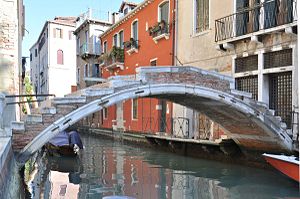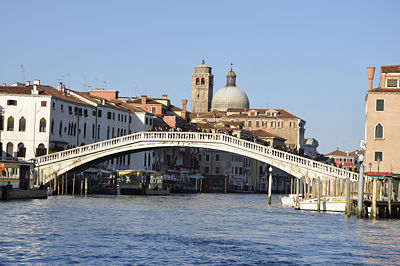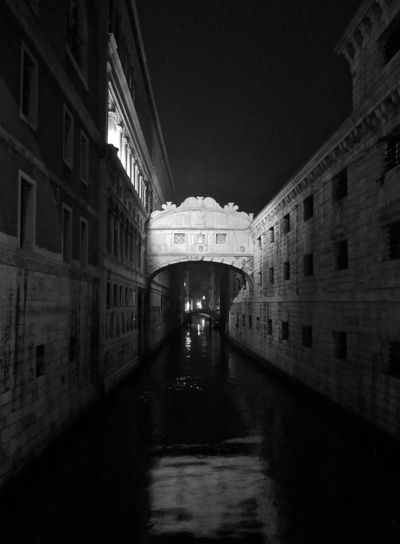Bridges of Venice

The Bridges of Venice are, to be exact 391, between public and private, not counting the islands, even the largest as the Giudecca, Murano, Burano, Torcello, whose bridges are counted separately.
When moving to Venice you must be provided with a pair of comfortable shoes to cross with relative ease the bridges that are encountered in the path that it was decided to undertake. The Venetians no longer count as bridges cross in their daily travels in Venice, while a tourist, unaccustomed to long walk, much less to climb the many steps, each bridge could become a torture, every step a stab at the side of the plant feet.
Originally it was not as many as today. It was flat and made of wood, as still seen in Plant from bird’s eye of Jacopo de Barbari, then, over the years, built arched, stepped, stone and brick . When were flat or with steps lower, deeper, to Venice circulating the carriages and the horses could graze in the fields at that time were not paved with stones.
Certainly the first wooden bridge was built immediately after the ducal seat was moved from Malamocco to Rialto in 813, enters the first stone bridge, as we read in Diaries of Marino Sanudo, was built a few centuries later by the Doge Pietro Sardonico near the Chiesa di San Zaccaria. Then came the first time worked to the Istrian stone which, from that time up to our days, was always used in all large buildings in the city.
But the king of all the bridges he has remained, the Rialto’s Bridge, that with wide arch of 28 meters wide and 22 meters high above the center line of tide 7.5 meters, crosses the Grand Canal. This bridge sums up in its former name the whole glorious history of the life of Venice commercial and seafaring: majestic giant that, as a triumphal arch thrown on the Grand Canal, has always dominated in all the popular festivities Venetian and still dominates particularly in Historical Regatta, which assists, silent witness to the passing of the colorful procession of Bissone, the Venetian Gondola dressed up to the nines, infiorate boats and fast Gondolini who compete to get to top four in bandiera, as in past centuries was covered with damask drapes to greet the Bucintoro blazing golds and silvers .

The first Rialto’s Bridge, wood and posante of boats, was built in the year 1180; then in 1264 it was built is one goal, but in 1444 fell for the crush of people flocked to witness the triumphant passage of the Marquise of Ferrara. Was rebuilt and still ruined by several fires until the Senate of the republic he decided to build one more solid stone. The assignment of the building was the architect Antonio Da Ponte that he completed in 1591. From then to the wide steps of the imposing bulk up and down the ladies in fur coats, the gallant gentlemen, the housewives, the merchants and caravans of tourists every nation: fluttuane mass of people over the centuries, as in the years of greatest prosperity of Venice, when you climbed the bejeweled matrons and the austere patricians, intermingled with the crowd of commoners with black fringed shawl over her shoulders, and merchants eastern and northern Europe, gathered here to sell spices, perfumes, fabrics and rare.

There is also another important bridge to remember, a must destination for those coming to Venice for the first time: the Ponte della Paglia, wide, with low steps and two beautiful backs in columns work well , built for the first time in 1337. Here they stop the tourists for the ritual photograph and linger there to stop your eye on the Bridge of Sighs, which is suspended between the Doges’ Palace and Palace Prison, awakening memories and grim legendary stories that the imagination of the common people has created.
Under that plane bridge that is flanked by two openings pierced and is reflected in the dark of Rio Palace, continue to slide read the Gondolas lovers to continue to enjoy the gentle rocking of the boat in cobweb of other culprits in the shade of other bridges.
The Ponte della Paglia reminds us of one of the most expensive Venetian legends, described by the brush of Paris Bondone. The framework, which is in Accademia Gallery, is titled ‘The delivery of the ring to the Doge’ . Legend has it that on the night of February 25, 1340 Venice was devastated by a terrible storm that threatened to engulf the entire city. A poor fisherman, repaired his boat under the bridge, showed a mysterious character by ordering traghettarlo island of San Giorgio Maggiore; but here he appeared a stranger, then a third party who insisted on being transported to St. Nicholas of Lido.
The fragile boat came off, was seen to meet a ship load of infernal spirits, but as soon as the three strangers made the sign of the cross, the ship sank in the waters with all the damned and immediately returned to the sea calm.
The three strangers, who were none other than San Marco, San Giorgio and Saint Nicholas, in parting from the boatman gave him a gold ring to cause the Doge, which in receiving it, immediately recognized that he kept in the Treasury of San Marco and that he had taken out of the invisible hand.
An old bridge that reminds us of another miraculous event is the Ponte di San Lorenzo from which, as the chronicles, in 1369, fell in the underlying Rio silver reliquary of the Holy Cross, the priest went in procession to the nearby church.
Sacred relic did not sink, but was miraculously to float on water until the official priest not jumped into the canal to take and bring back to the waterfront. This fact was later, in 1500, immortalized by the brush of Gentile Bellini in his beautiful painting, known as the Miracle of the Cross, now in the Accademia Gallery.
There is also a bridge that popular imagination has given birth in one night by mysterious hands and called Ponte de le Meravegie, in the fifteenth century.

Arco del Paradiso con insegne araldiche – VeniceWiki
There is another bridge whose construction was attributed to the devil and it is said Devil’s Bridge and not long since this is the Bridge of Heaven which gives access to the homonymous Calle del Paradiso of the fourteenth century.
Among the best known and busiest bridges mentions the Scalzi Bridge, bold and elegant stone building, overlooking the Grand Canal near Railway Station Saint Lucia and is not far find the Guglie Bridge, so called by the four decorative obelisks, was built in 1580 in Istrian stone horse of the large Cannaregio Canal.
The so-called ‘infamous bridges will remember just one. In order to give the public as to the severity of justice, the Venetian government had ordered that some sentences, such as the cutting off of hands, tongue and the execution of the quartering were performed on some bridges. Such unedifying shows there remains the memory in Ponte dei Squartai, Bridge of quartered near Tolentini. So it was not enough that the murderess was sent to another world with a single blow of the ax, but thick time that unfortunate was torn to pieces, quartered, which were then exhibited in four parts of the city because the citizens They knew the name, the crime committed and the conviction of the culprit.

Ponte dei Pugni – VeniceWiki
Instead of several Venetian bridges, especially of those who then had the bande, the parapets protectors, it took place the fights between peasants of different districts. These struggles took the form of real fights, were made several times a year and unsuccessful, pests from bastoate and fists, usually ended in the waters of the channel below.
The memory of these fights, which lasted until the beginning of 1705, is still alive in the name of Ponte della Guerra from San Marco and Campo Santa Maria Formosa in Ponte di Santa Fosca and Ponte dei Pugni in San Barnaba, who went up to the early twenty-first century when remade the paving of bridges, still bore the imprints on the middle shelf of the feet in marble on which contestants posed just before the start of the fight.
At one of these fights with sticks witnessed in 1574 King Henry III of France, who was then a guest of the Serenissima. The fight which took place on Ponte Foscarini to Carmini, attended as many as 200 people, 100 per share, which at the end the king wanted to reward with several gold ducats.
Of historic bridges in Venice there are many. All have devoted their name to some important event.
On Ponte di San Polo in 1548 Lorenzino de Medici and his uncle Alessandro Soderini were killed by two assassins paid by Duke Cosimo.
On Ponte Santa Fosca on the evening of October 5, 1607 Fra Paolo Sarpi was attacked by five individuals, part of his enemies. Today in Campo Santa Fosca beautiful bronze monument dedicated to the illustrious friar served.
The Ponte Storto in Sant’Aponal climbs on the building where he was born the seductive Bianca Cappello, who had a relationship with a young Florentine, fled with him in Florence, where, a few years later, he met the Duke Francesco de Medici, who married her, and where in 1687, they both died of poison.
To Bridge Holy Apostles, which preserves the avenzi decorative XIII-XIV century, there is still the building that was the Doge Marino Faliero who, but as a result of its’ thoughts he was imprisoned in April 1355 beheaded.
Other bridges have reason to be appointed, even for the lives of some artists who have lived in those places, as in the Parish of San Canciano in the vicinity of the bridge lived and died the great Tiziano Vecellio.
The Marco Polo Bridge there was the home of Polo where Marco Polo spent his childhood and the last years of his troubled existence.
To Ponte San Basegio was born and lived the distinguished portraitist Rosalba Carriera.
To Ponte de la Calcina died in 1750 the poet laureate Apostolo Zeno.
To Ponte San Tomà was born and lived Carlo Goldoni, whose house is now a national monument.
To Ponte dei Fuseri from 29 September to 1 October 1786 lodged Wolfgang Goethe.
To Ponte della Cortesia is the building from which the patriot Daniele Manin in 1849 he left for exile.
How many are in total the steps of all the bridges of Venice?
The Rialto’s Bridge has a total of 316 steps, as described in the relevant page, while the other three bridges crossing the Grand Canal have, respectively, 80 the Scalzi Bridge, the 122 Accademia Bridge, the 106 Constitution Bridge, for a total of 624 steps.
Having a precise number of bridges which connect the various islands that make Venice, would curiosity also know how many they are, in total, the steps that make up the various bridges to have, then, a total number of steps that you can climb and down through all the bridges of Venice.



